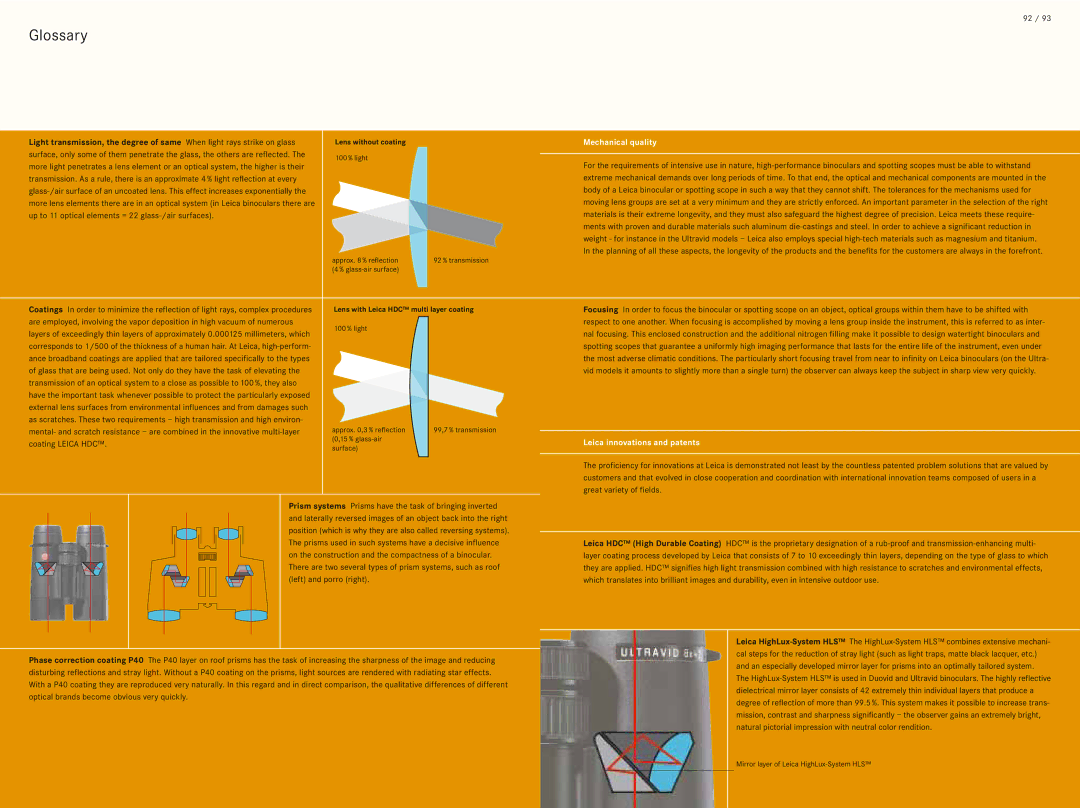
Glossary
92 / 93
Light transmission, the degree of same When light rays strike on glass surface, only some of them penetrate the glass, the others are reflected. The more light penetrates a lens element or an optical system, the higher is their transmission. As a rule, there is an approximate 4 % light reflection at every
Coatings In order to minimize the reflection of light rays, complex procedures are employed, involving the vapor deposition in high vacuum of numerous layers of exceedingly thin layers of approximately 0.000125 millimeters, which corresponds to 1/500 of the thickness of a human hair. At Leica,
Lens without coating
100 % light
approx. 8 % reflection | 92 % transmission |
(4 % |
|
Lens with Leica HDC™ multi layer coating
100 % light
approx. 0,3 % reflection | 99,7 % transmission |
(0,15 % |
|
surface) |
|
Mechanical quality
For the requirements of intensive use in nature,
In the planning of all these aspects, the longevity of the products and the benefits for the customers are always in the forefront.
Focusing In order to focus the binocular or spotting scope on an object, optical groups within them have to be shifted with respect to one another. When focusing is accomplished by moving a lens group inside the instrument, this is referred to as inter- nal focusing. This enclosed construction and the additional nitrogen filling make it possible to design watertight binoculars and spotting scopes that guarantee a uniformly high imaging performance that lasts for the entire life of the instrument, even under the most adverse climatic conditions. The particularly short focusing travel from near to infinity on Leica binoculars (on the Ultra- vid models it amounts to slightly more than a single turn) the observer can always keep the subject in sharp view very quickly.
Leica innovations and patents
The proficiency for innovations at Leica is demonstrated not least by the countless patented problem solutions that are valued by customers and that evolved in close cooperation and coordination with international innovation teams composed of users in a great variety of fields.
Prism systems Prisms have the task of bringing inverted and laterally reversed images of an object back into the right position (which is why they are also called reversing systems). The prisms used in such systems have a decisive influence on the construction and the compactness of a binocular. There are two several types of prism systems, such as roof (left) and porro (right).
Phase correction coating P40 The P40 layer on roof prisms has the task of increasing the sharpness of the image and reducing disturbing reflections and stray light. Without a P40 coating on the prisms, light sources are rendered with radiating star effects. With a P40 coating they are reproduced very naturally. In this regard and in direct comparison, the qualitative differences of different optical brands become obvious very quickly.
Leica HDC™ (High Durable Coating) HDC™ is the proprietary designation of a
Leica
The
Mirror layer of Leica
